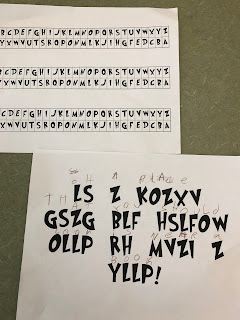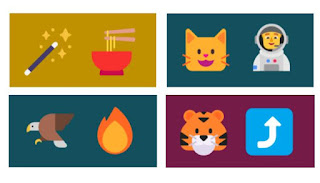"Breaking Out" for Read Across America 2019
This week we celebrated Read Across America Day. Yes, we celebrated. Our school has historically used this day to spread the love of reading by inviting students and staff to dress as their favorite book characters. In our school, the day is more of a celebration of READING rather than a celebration of a single author.
Our week had several parts, but all were student-centered and student-led. Honestly, it was an exhausting week of trying to stay one step ahead of activities (like racing to relock the Breakout box), but the independence and leadership that I saw in students made it all worthwhile. Our activities for the week:
Coordinates or puzzle about Dr. Seuss's birth date
Invisible ink
Groups solved their clues (or didn't and asked for help from each other or myself). They worked together (or didn't - see below). When I could see that a class was not going to break out in time we reconvened on the rug and we worked through the clues together so they could be successful.
Inside the box they discovered a Cat in the Hat hat and the real prize - a note informing them they earned 15 minutes of game time the following week.
When a 5th grader asked to be in charge of putting the box back together I responded, "Yes! Of course!" They were invested and wanted to be part of the setup for the next class. (This was also super helpful).
I loved having 2 sets of breakouts available. This enabled me to mix and match according to the class that was walking in the door. For example, I found that a 5th-grade class breezed through the coordinates clue and were done in 3 minutes, so I had the next 5th-grade class do a puzzle clue which required a second step of finding Dr. Seuss's birthday (the clue that I prepared for younger grades).
Our week had several parts, but all were student-centered and student-led. Honestly, it was an exhausting week of trying to stay one step ahead of activities (like racing to relock the Breakout box), but the independence and leadership that I saw in students made it all worthwhile. Our activities for the week:
- All classes participated in a Dr. Seuss BreakoutEdu.
- We celebrated as a school by dressing up as favorite book characters.
- We gathered as a school to celebrate reading, hosted by our Student Council. The assembly featured a teacher costume contest (with student judges) and a video of student costumes, with our Reader Leaders as event photographers.
 |
| This announcement served as our first clue that we solved together. |
Dr. Seuss BreakoutEdu
I wanted ALL classes to participate in a BreakoutEdu this week. In the fall our 4th and 5th graders did the Dot Day breakout, but not all classes were successful. (I have used breakouts in the past and reflected on our first one here). My goal for the week was to have every class participate and to help every class succeed. My challenge - how to make this work with a fixed schedule where I have back-to-back classes and no time between classes to make the magic happen.
The REAL work happened at home in the planning phase. I began with Patti Harju's Oh, The Places You'll Go breakout, found an adapted breakout for younger students by Susan Stewart, and created a combination of the both.
Challenge #1: Time - we only have 30 minutes to do this. How do I present the activity, ground rules, and complete this in the short amount of time?
Solution #1: My explanation took only 5-6 minutes, and I set it up so we would solve the first clue as a class. This models the activity AND reduces the number of locks.
Challenge #2: How do I use 2 breakouts (one for older students, one for younger) and still keep my sanity? I don't have time between classes to change locks!
Solution #2: There were 5 locks and we have 5 table groups. Each table represented a lock. I would have to change clues out when we shifted from older to younger grades, but the locks stayed the same. For example, this meant that the 3 number lock was always 4-7-3 whether the younger students counted apples or the older students deciphered the boarding passes. I also kept 2 clues the same for everyone.
 |
| Older students contemplate what these boarding pass clues mean. |
Code deciphering (easy and more challenging version)
 |
| This pictorial and shorter version was perfect for 1st and 2nd graders. |
 |
| Older students had a longer message to decipher. |
 |
| All grades used this clue as well. |
Groups solved their clues (or didn't and asked for help from each other or myself). They worked together (or didn't - see below). When I could see that a class was not going to break out in time we reconvened on the rug and we worked through the clues together so they could be successful.
Inside the box they discovered a Cat in the Hat hat and the real prize - a note informing them they earned 15 minutes of game time the following week.
When a 5th grader asked to be in charge of putting the box back together I responded, "Yes! Of course!" They were invested and wanted to be part of the setup for the next class. (This was also super helpful).
 |
| A 5th grader hides the key under a bin of books for the next class. |
My takeaways
I loved having 2 sets of breakouts available. This enabled me to mix and match according to the class that was walking in the door. For example, I found that a 5th-grade class breezed through the coordinates clue and were done in 3 minutes, so I had the next 5th-grade class do a puzzle clue which required a second step of finding Dr. Seuss's birthday (the clue that I prepared for younger grades).
No two classes are the same. What one class found challenging, the next class breezed through. For example, I had a 3rd-grade class that had to turn in a hint card (and I helped them significantly) through their apple counting. They were the last group to get in their lock. My 2nd-grade class following this group opened this lock first.
Leaders emerge and the unexpected arise. Observing the quiet students lead the group to success or the academically challenged students lead the group to the solution was a beautiful confidence booster for them. More than once I anticipated that the brain in the group would have the clue solved in no time, only to find that they "overthought" the clue and drove themselves into dead ends.
Group dynamics were fascinating to watch. Of course not all groups worked well together. ("Mrs. Garland, she is doing everything herself!" or I have one student who asks for help and the rest of the group is off-task elsewhere).
Community building was priceless. The celebrations of each lock being removed was 100% pure joy! This activity brought the classes together. Together they worked to break into the box and earn a reward for the entire class that will require them to work together again next week. (They earned 15 minutes of game time next week. We will have screen-free game time). My favorite quote of the week, "My mother should do this for our family. We don't always get along and this helped us to work together." - 3rd grader







Comments
Post a Comment